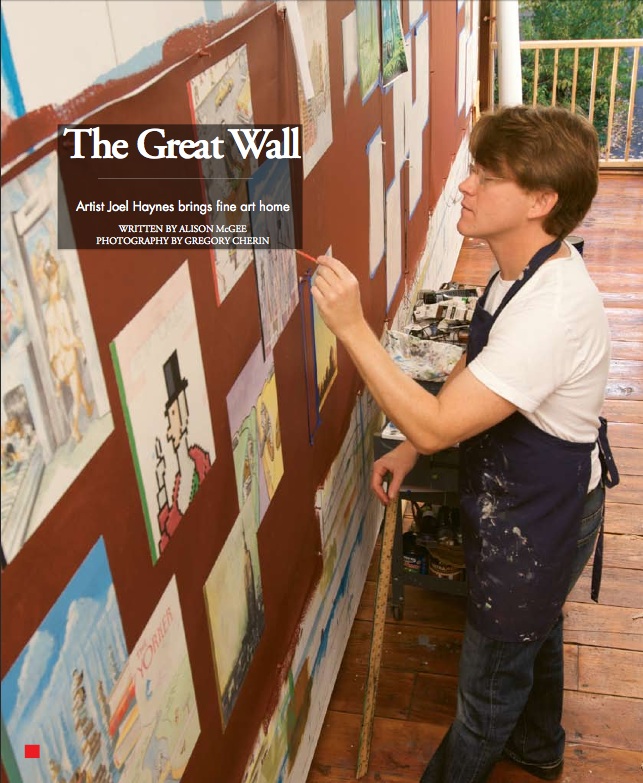The Great Wall – Artist Joel Haynes brings fine art home, Written by Alison McGee, Photography by Gregory Cherin, Berkshire Living, May 2009 (pdf)
Maybe it’s the subtle hint of his lingering Southern accent, or the easy smile as his eyes light up about each and every project he describes.Or maybe it’s the drum set that fills the corner of his studio, momentarily catching the eye before the pull of a deep crimson canvas stretched along a twenty-foot wall steals the show.The canvas is dotted with a collage of New Yorker magazine covers, which are only given away by the unfinished squares where blue tape outlines pencil sketches awaiting the touch of paint-gobbed brushes resting on a cart nearby. It’s hard to say just where the charm hits home most, but it’s possible that it’s with his subtle, often whimsical details that Joel Haynes makes his mark, even on the largest-scale works he creates. Affectionately admiring a scrap — if you can call it that — left over from a past mural, Haynes exclaims that a bee can be found in almost every mural he’s painted. And while he plans to start a series of bee-centric pieces, that project is just one of many eclectic items on his to-do list.
Despite the creamy, unadorned perimeter of Haynes’s studio space in Great Barrington, Massachusetts, the former hayloft displays many facets of the forty-four-year-old’s creative genius. A large floor-to-ceiling panel—twenty feet in length and etched with measurements and a rainbow of brushstrokes from past projects—divides the lofty room and acts as a large-scale sketchbook displaying not only Haynes’s current mural project, but also an indecipherable structure hanging mysteriously at the top.
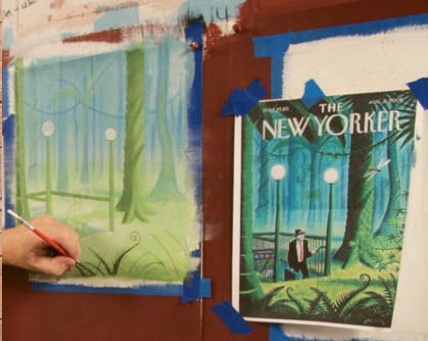 Around the corner of the divider wall, which Haynes installed to expand his available working area, is a wall-mounted portfolio of designs, blueprints, and samples from his numerous past projects: muted gold and pink tones, graceful floral patterns, and surface treatments ranging from tortoiseshell and marble to stucco and knotted wood. Though most of Haynes’s art is designed for the home, he typically creates a canvas in his own studio, almost to completion, before bringing it to a client’s home for final installation and touchup. Very soon, the red canvas with the unfinished New Yorker covers will be transported to a Stockbridge, Massachusetts, couple’s new loft in San Francisco. The project has taken Haynes about six months to complete, and he is wrapping up the details on what will become a trompe l’oeil collage of reproductions of the magazine’s signature cartoons and ten of its covers. “I’m illustrating New Yorker covers!” exclaims Haynes, laughing about the speed with which he’s been able to re-create the small reproductions of the more time- consuming originals. the client is an interior designer planning to surprise her husband with the mural in their powder room as a tribute to his leaving a thirty-year Wall street career for a new one in san Francisco. And she is much less modest than Haynes in her description of his work, expressing amazement at his “ability to capture not only the [magazine] image so accurately, but his ability to imitate the painterly style of the individual artists” whose work he is re-creating.
Around the corner of the divider wall, which Haynes installed to expand his available working area, is a wall-mounted portfolio of designs, blueprints, and samples from his numerous past projects: muted gold and pink tones, graceful floral patterns, and surface treatments ranging from tortoiseshell and marble to stucco and knotted wood. Though most of Haynes’s art is designed for the home, he typically creates a canvas in his own studio, almost to completion, before bringing it to a client’s home for final installation and touchup. Very soon, the red canvas with the unfinished New Yorker covers will be transported to a Stockbridge, Massachusetts, couple’s new loft in San Francisco. The project has taken Haynes about six months to complete, and he is wrapping up the details on what will become a trompe l’oeil collage of reproductions of the magazine’s signature cartoons and ten of its covers. “I’m illustrating New Yorker covers!” exclaims Haynes, laughing about the speed with which he’s been able to re-create the small reproductions of the more time- consuming originals. the client is an interior designer planning to surprise her husband with the mural in their powder room as a tribute to his leaving a thirty-year Wall street career for a new one in san Francisco. And she is much less modest than Haynes in her description of his work, expressing amazement at his “ability to capture not only the [magazine] image so accurately, but his ability to imitate the painterly style of the individual artists” whose work he is re-creating.
An illustrator at heart, Haynes says that this particular project provides an outlet for that creativity, honed while studying at the Ringling school of Art and Design in Sarasota, Florida, which led to a job as a magazine illustrator in the age before digitalization took over the industry. After the changeover, Haynes strayed from his early dream of becoming a cover artist of science-fiction novels, and, in need of work, entered the field of decorative painting in 1990. A one-year stint in Maui convinced him that it beat working in a formal office setting. now, after more than fifteen years based mostly in Florida, Haynes has defined his own style and travels around the country as well as to several international locations to cater to an expanding clientele.
“In this business, you have to spin a lot of plates,” Haynes says, detailing the range of projects he has completed. Most of the time, using simply acrylic paint, Haynes re-creates traditional decorative finishes as well as more unique ones, such as stainless steel, rusted steel, leather, and fur. “I did a faux zebra-skin rug,” he adds, describing how he created each individual strand of fur as a humane tromp l’oeil alternative to the real thing. “He has tremendous diversity,” interior designer Barbara Boughton says of the talents she’s witnessed after working with him on several design projects over the years. “Joel makes things very easy.”
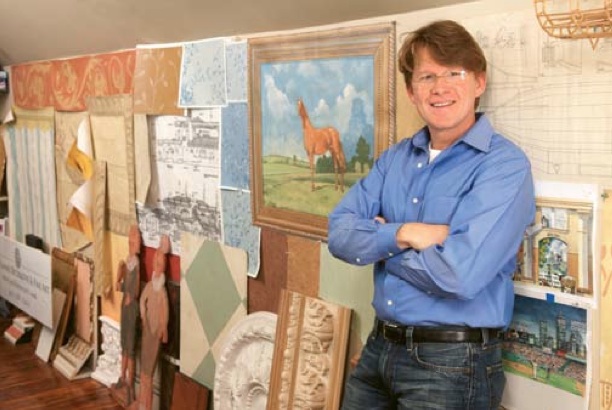 When Haynes and his wife, Jennifer Curry, decided to follow friends’ advice and enroll their daughter in Great Barrington’s Rudolf Steiner School, they found themselves introduced to a community very different from the gated ones they knew in Florida.
When Haynes and his wife, Jennifer Curry, decided to follow friends’ advice and enroll their daughter in Great Barrington’s Rudolf Steiner School, they found themselves introduced to a community very different from the gated ones they knew in Florida.
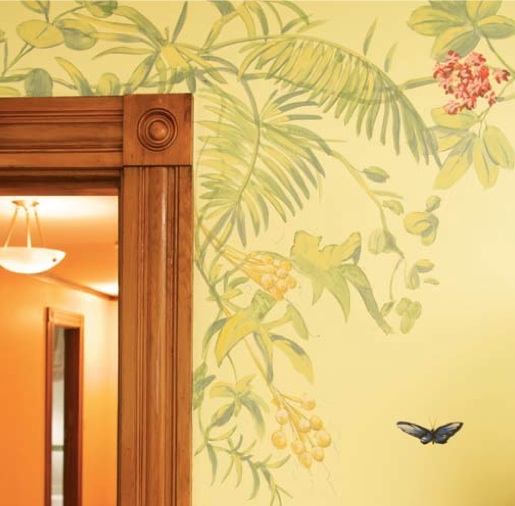 Haynes and Curry, who are both familiar with small-town life from growing up in Tennessee, had begun to tire of the excessive development that seemed to be overtaking the state. “It’s tainted down in Florida,” says Haynes, adding that they immediately formed strong bonds of friendship in the Berkshire when they moved north five years ago. Appreciation for the arts here is an added bonus for Haynes and Curry, also an artist. It’s a very different pace of life — and very different scenery, which Haynes says inspires variety in the subject matter of his murals. “But I’m really good at palm trees!” he quips.
Haynes and Curry, who are both familiar with small-town life from growing up in Tennessee, had begun to tire of the excessive development that seemed to be overtaking the state. “It’s tainted down in Florida,” says Haynes, adding that they immediately formed strong bonds of friendship in the Berkshire when they moved north five years ago. Appreciation for the arts here is an added bonus for Haynes and Curry, also an artist. It’s a very different pace of life — and very different scenery, which Haynes says inspires variety in the subject matter of his murals. “But I’m really good at palm trees!” he quips.
Working with interior designers is only part of Haynes’s creative milieu. A drafting table in the corner of his studio is flanked by a delicate-looking wooden airship and pictures of similar contraptions. The piece, which Haynes crafted himself years ago from blueprints that still hang behind it, was broken irreparably during the move from Florida. While Haynes explains (with some regret) that he’s abandoned that particular design, he has not abandoned his love affair with the unique flying craft. in fact, the mysterious structure hanging near his ceiling is a sleeping pod-like invention whose skeleton is modeled after that of a dirigible. leafing through a sketchbook, Haynes reveals several more sketches that hark back to his sci-fi roots. “i fall between the fine-artist guy … and those people who paint those vans with Star Wars themes,” Haynes says. such a mixture of interests is underscored by Haynes’s collection of Hindenburg DVDs and zeppelin puzzles sitting on a shelf beside fluttering samples of elegant trims and stone textures.
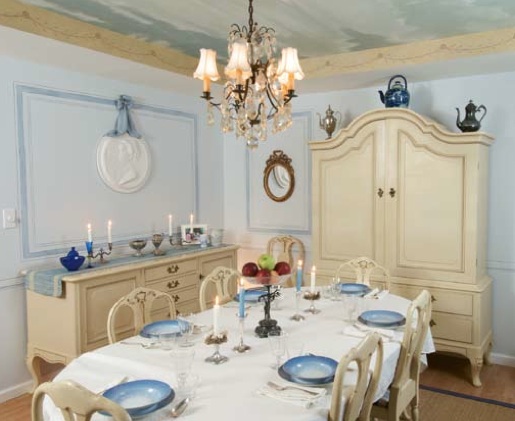 A vibrant blue strip of canvas partially painted with swooping lines and dots hangs across from the delicate examples of his designs. this, however, is not a part of Haynes’s interior decorating portfolio; it is yet another project that has branched out of his eclectic interests. A drummer himself, Haynes recently reached out to percussion design companies with a proposition: “Hand-painting is something that’s never going to go out” of style, he says. Though he makes the point that it’s often easy for drum companies to sell “hand-painted” instruments that are simply airbrushed,Haynes is working on a proposal for a line of high-end, fine-art drum sets.
A vibrant blue strip of canvas partially painted with swooping lines and dots hangs across from the delicate examples of his designs. this, however, is not a part of Haynes’s interior decorating portfolio; it is yet another project that has branched out of his eclectic interests. A drummer himself, Haynes recently reached out to percussion design companies with a proposition: “Hand-painting is something that’s never going to go out” of style, he says. Though he makes the point that it’s often easy for drum companies to sell “hand-painted” instruments that are simply airbrushed,Haynes is working on a proposal for a line of high-end, fine-art drum sets.
Like the rest of his studio, his own drum set is neutral in color, but Haynes says he hopes to decorate both his instrument and the pale walls with his own designs in the future, somehow incorporating his many enthusiasms while balancing the ever-changing rotation of works-in-progress. Whether it’s a faux-stone fireplace, an intricate trim, an illustrated tale of a fox and a hedgehog, or a sentimental tribute to a city and one of its most notable publications, Haynes’s affection for imagination and antiquity comes through in each brushstroke. BL
Alison McGee is assistant editor of Berkshire living.

